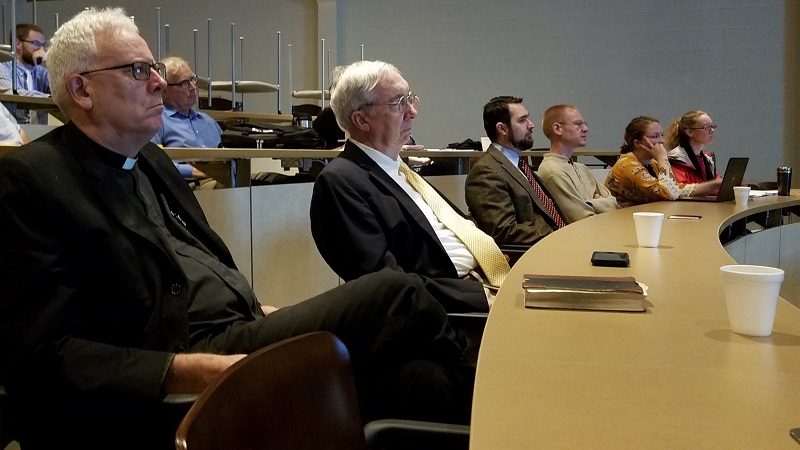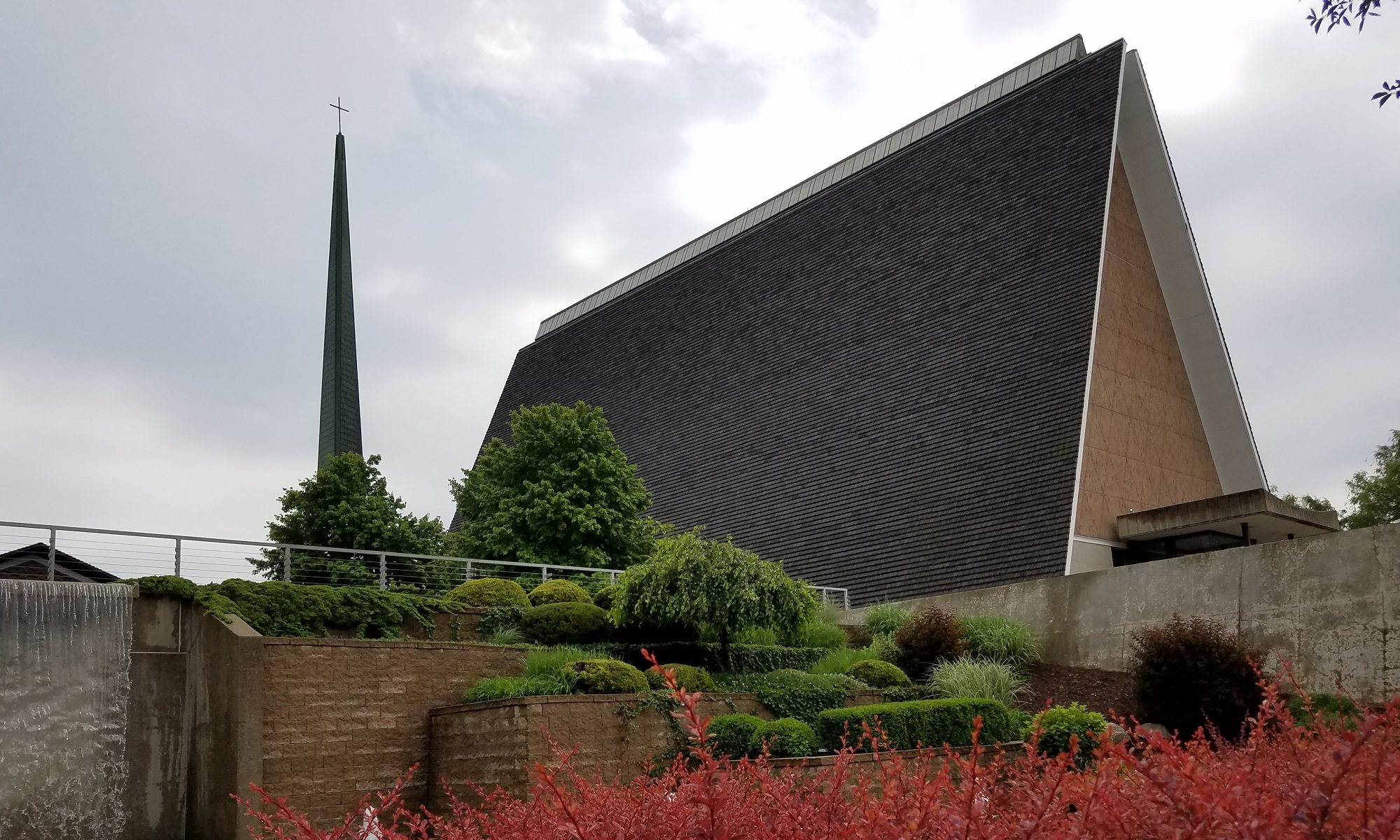There’s a lot of extra learning opportunities on campus this week, from Lutheranism & the Classics (a two-day, bi-annual conference for those interested in the conjunction between theology and the study of classical antiquity) today and tomorrow, to the Christ Academy: Confirmation Retreat coming up this weekend. But the learning first started this week with a convocation on Wednesday, when Dr. Cynthia Lumley, Principal of Westfield House of Theological Studies in Cambridge UK, lectured on “Lutheranism in England.”

Our former Associate Director of Deaconess Formation, Dr. Lumley makes the trip back to CTSFW nearly every year to talk to the students about studying abroad at Westfield House. Westfield House exists alongside Cambridge, as seminarians in Britain are expected to go to an academic college to earn an academic theology degree, while simultaneously attending a house of their specific denomination, which teaches them their doctrine and how to interpret the things they’re learning in their academic degree. Westfield House is a sister seminary of the LCMS, as we are in partnership with the ELCE (Evangelical Lutheran Church of England).
The Lutheran presence in the UK is small, as it has always historically been. Great Britain is, in fact, rapidly changing into a mission field for all denominations, with 70% of 16 to 29-year-olds identifying no religious affiliation as secularism becomes the dominant cultural force. Only 5% of the population attends church (25% of whom are Anglican, 22% Catholic, while Lutherans fall into the “other denominations” category).
Christianity first came to Britain in the early AD’s, with legend claiming that Joseph of Arimathea came to England’s shores in 63 AD. The English hymn “Jerusalem” by William Blake (considered, by many Brits, to be England’s unofficial national anthem) refers to this. The first recorded British Christian was St. Alban, martyred in AD 209, while the oldest archaeological evidence of Christianity is a Chi-Rho wall painting from AD 350. However, much of England fell to paganism for the next couple centuries, though Christianity remained in Scotland, Wales, and Ireland. These Christians refused to try and convert the pagan Anglo-Saxons (according to Dr. Lumley they legitimately wanted them to burn in hell), they also did not stand in Augustine’s way when the first archbishop of Canterbury came as a missionary in the 600s, allowing him to reintroduce Christianity to the lost.
Skipping forward nearly 1,000 years to the introduction of Lutheranism:
Within four weeks of October 31, 1517, the 95 theses had been smuggled into the east coast ports from Antwerp and were being debated in pubs, particularly by the White Horse Inn Group. Henry the VIII declared Luther a heretic and the pope rewarded him with the title of “Defender of the Faith.” The pope took back the title when Henry VIII broke with Catholicism and declared himself head of the Church of England so that he could divorce his wife, but parliament later voted it back in again. “Defender of the Faith” has been one of the official titles of every ruling monarch since and is on all English coins, generally abbreviated as Fid. Def. or simply F.D.
Henry VIII had at least one Lutheran Queen and maybe two: Anne of Cleves and possibly Ann Boleyn, the mother of Elizabeth I. Elizabeth re-established the Church of England (mother church of Anglicanism), which remains the only protestant faith that has not splintered into separate denominations. However, it has done so by housing many diverse and often opposing beliefs within it. “Because it tries to be everything to everyone,” Dr. Lumley explained, “the Church of England has no clear statement of faith.”
However, the Augsburg Confession can be found in the 39 Articles of the Church of England; five of the articles are almost identical to the Augsburg Confession and another 11 are rewritten versions. Furthermore, the Anglican forms of communion, marriage, confirmation, baptism, and burial were influenced by early Lutheran orders.
The first official Lutheran church in Britain began in 1672, and 17 years later the Toleration Act of 1689 permitted the existence of Protestant groups outside of the Church of England as long as they accepted the doctrine of the Trinity. There was actually a Lutheran King as well: George I in 1714, who was, by royal duty, simultaneously the head of the Church of England. He spoke German and no English, and his presence brought a lot of German immigrants into the court. Lutheranism became the third most common religion at court, though it remained foreign to the common people. By 1728, there were five Lutheran churches in London.
As to the history of the ELCE (Dr. Lumley added, with some amusement, that at every conference their two congregations in Scotland and Wales try to vote “England” out of the Synod’s official name), began on January 1, 1954, though it can trace its roots back to 1896 and six German bakers. These six founders asked Concordia Seminary in St. Louis for a pastor, each of them pledging a fifth of their weekly 25 shillings pay to support him. They were members of the LCMS Atlantic District from 1911-1954, until they were able to establish their own Synod in 1954 with the help of the LCMS. Rev. Norman Nagel was installed as their first pastor on January 3, 1954.
Rev. Nagel had been called to the ELCE to Cambridge to get a Ph.D. and to establish a seminary. He managed to obtain prime Cambridge property for Westfield House by following a rumor. He had heard that a professor was thinking of retiring and so boldly knocked on the man’s door to ask if this were true. He invited Rev. Nagel in for tea (“Apart from the pub,” Dr. Lumley noted, “all the best conversations happen over tea.”) and agreed to sell the property to the church. Though the doctor later received several higher offers, he stuck by his original promise. Westfield House’s first chapel was a shed some of the students cleaned out.
At this present time, the ELCE has 14 congregations, 6 missions, and about 800 members spread across the UK. Their 11 pastors hail from 9 different countries, and many of their students come to Westfield House through study abroad programs. Westfield House is a training center for those who have no seminary, including African and East Europe.
The Lutheran church in the UK faces a lot of struggles because of its small size. There are vacant pulpits – not simply because of a lack of pastors, but because of a lack of funds – and pastors often take on dual parishes. Challenges that face Lutheranism in the UK includes:
1. Historically, Germans were persona non-grata after both wars, and Lutheranism is – or, perhaps more accurately, WAS – seen as a German denomination.
2. Size. Their small numbers outreach difficult.
3. Lutheran worship does not feel familiar. ELCE churches’ use the LSB as their hymnal, which means even the spelling of Savior (Saviour) is immediately foreign and unfamiliar to their eyes; it seems like a small thing, but it’s not.
4. The deeply British value of toleration, which has been taken so far that it’s almost becoming intolerant to Christianity.
On September 25, 2010, following the Dedication of Luther Hall, Dr. Norman Nagel wrote the following to his “Dear Friends of Westfield House”:
“How super abundant are our Lord’s blessings. He brought us through the lean years when some people were willing to let Westfield House die. But the faithful staff and loyal Friends of Westfield House held on. And today we celebrate the lives of our Lord will bless through their lodging and studying in this building. My heart is with you with overflowing and joyful gratitude.”
Thanks be to God for His faithfulness. It was a pleasure to have you with us, Dr. Lumley, to teach us about the history of Lutheranism in the UK, and to help us to better know our brothers and sisters in Great Britain. Thank you!

